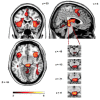Mesocorticolimbic Interactions Mediate fMRI-Guided Regulation of Self-Generated Affective States
- PMID: 32276411
- PMCID: PMC7226604
- DOI: 10.3390/brainsci10040223
Mesocorticolimbic Interactions Mediate fMRI-Guided Regulation of Self-Generated Affective States
Abstract
Increasing evidence shows that the generation and regulation of affective responses is associated with activity of large brain networks that also include phylogenetically older regions in the brainstem. Mesencephalic regions not only control autonomic responses but also participate in the modulation of autonomic, emotional, and motivational responses. The specific contribution of the midbrain to emotion regulation in humans remains elusive. Neuroimaging studies grounding on appraisal models of emotion emphasize a major role of prefrontal cortex in modulating emotion-related cortical and subcortical regions but usually neglect the contribution of the midbrain and other brainstem regions. Here, the role of mesolimbic and mesocortical networks in core affect generation and regulation was explored during emotion regulation guided by real-time fMRI feedback of the anterior insula activity. The fMRI and functional connectivity analysis revealed that the upper midbrain significantly contributes to emotion regulation in humans. Moreover, differential functional interactions between the dopaminergic mesocorticolimbic system and frontoparietal networks mediate up and down emotion regulatory processes. Finally, these findings further indicate the potential of real-time fMRI feedback approach in guiding core affect regulation.
Keywords: anterior insula; emotion regulation; midbrain; periaqueductal gray; real-time fMRI; reinforcement learning.
Conflict of interest statement
The authors declare no conflict of interest.
Figures




Similar articles
-
Functional Involvement of Human Periaqueductal Gray and Other Midbrain Nuclei in Cognitive Control.J Neurosci. 2019 Jul 31;39(31):6180-6189. doi: 10.1523/JNEUROSCI.2043-18.2019. Epub 2019 Jun 3. J Neurosci. 2019. PMID: 31160537 Free PMC article.
-
Transient and sustained BOLD signal time courses affect the detection of emotion-related brain activation in fMRI.Neuroimage. 2014 Dec;103:522-532. doi: 10.1016/j.neuroimage.2014.08.054. Epub 2014 Sep 7. Neuroimage. 2014. PMID: 25204866
-
The Brainstem in Emotion: A Review.Front Neuroanat. 2017 Mar 9;11:15. doi: 10.3389/fnana.2017.00015. eCollection 2017. Front Neuroanat. 2017. PMID: 28337130 Free PMC article. Review.
-
Training emotion regulation through real-time fMRI neurofeedback of amygdala activity.Neuroimage. 2019 Jan 1;184:687-696. doi: 10.1016/j.neuroimage.2018.09.068. Epub 2018 Oct 1. Neuroimage. 2019. PMID: 30287300 Clinical Trial.
-
Neural Circuitry of Impaired Emotion Regulation in Substance Use Disorders.Am J Psychiatry. 2016 Apr 1;173(4):344-61. doi: 10.1176/appi.ajp.2015.15060710. Epub 2016 Jan 15. Am J Psychiatry. 2016. PMID: 26771738 Free PMC article. Review.
References
-
- Buhle J.T., Kober H., Ochsner K.N., Mende-Siedlecki P., Weber J., Hughes B.L., Kross E., Atlas L.Y., McRae K., Wager T.D. Common representation of pain and negative emotion in the midbrain periaqueductal gray. Soc. Cogn. Affect. Neurosci. 2013;8:609–616. doi: 10.1093/scan/nss038. - DOI - PMC - PubMed
LinkOut - more resources
Full Text Sources

